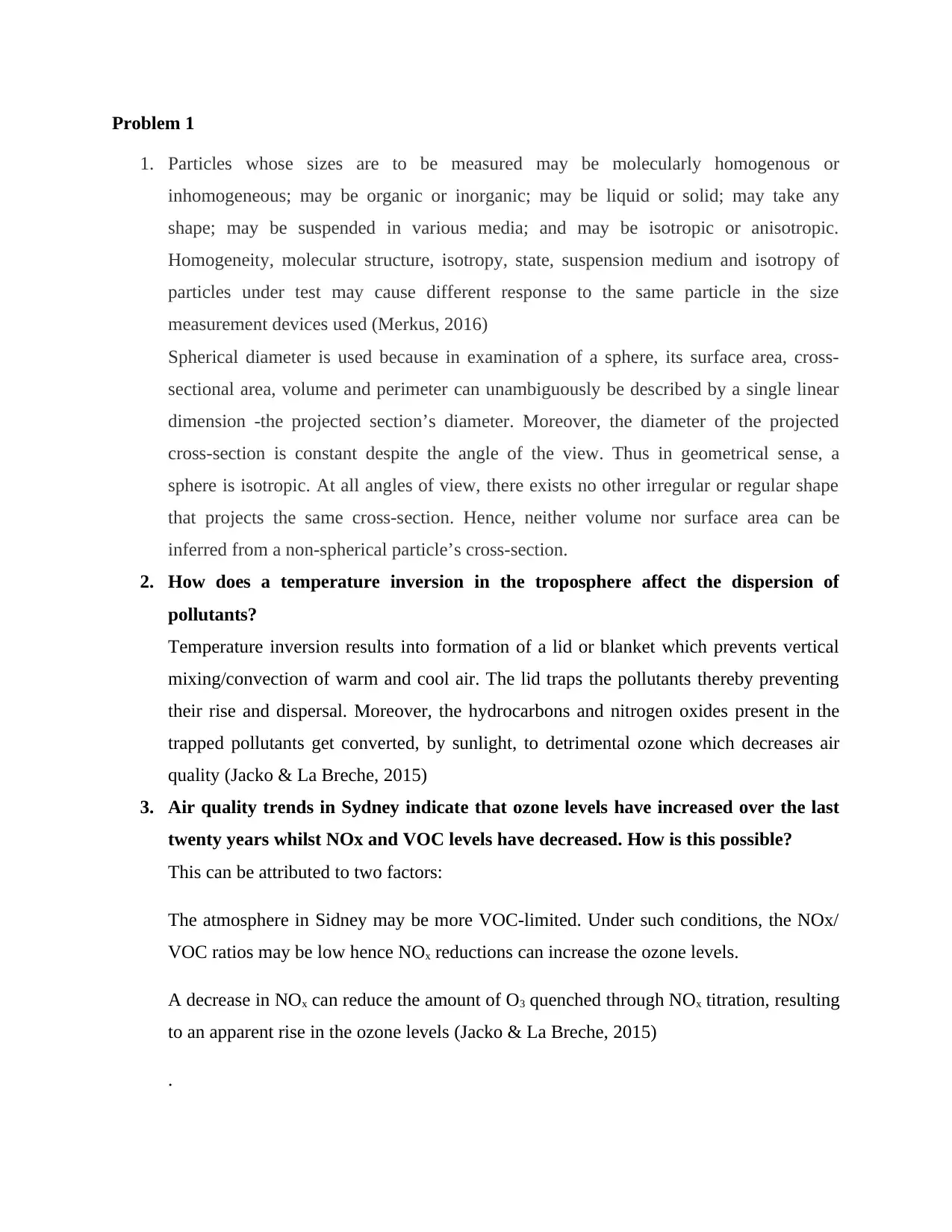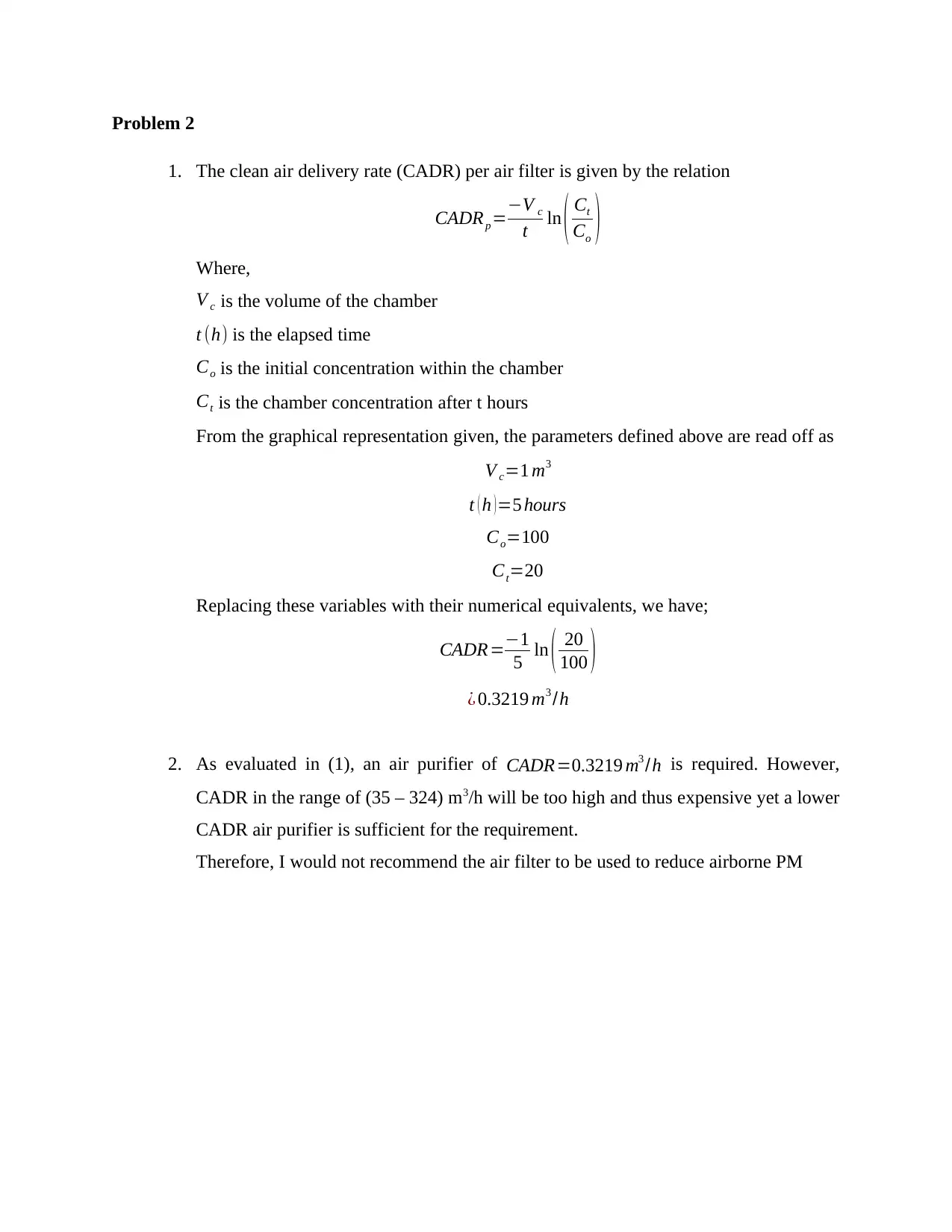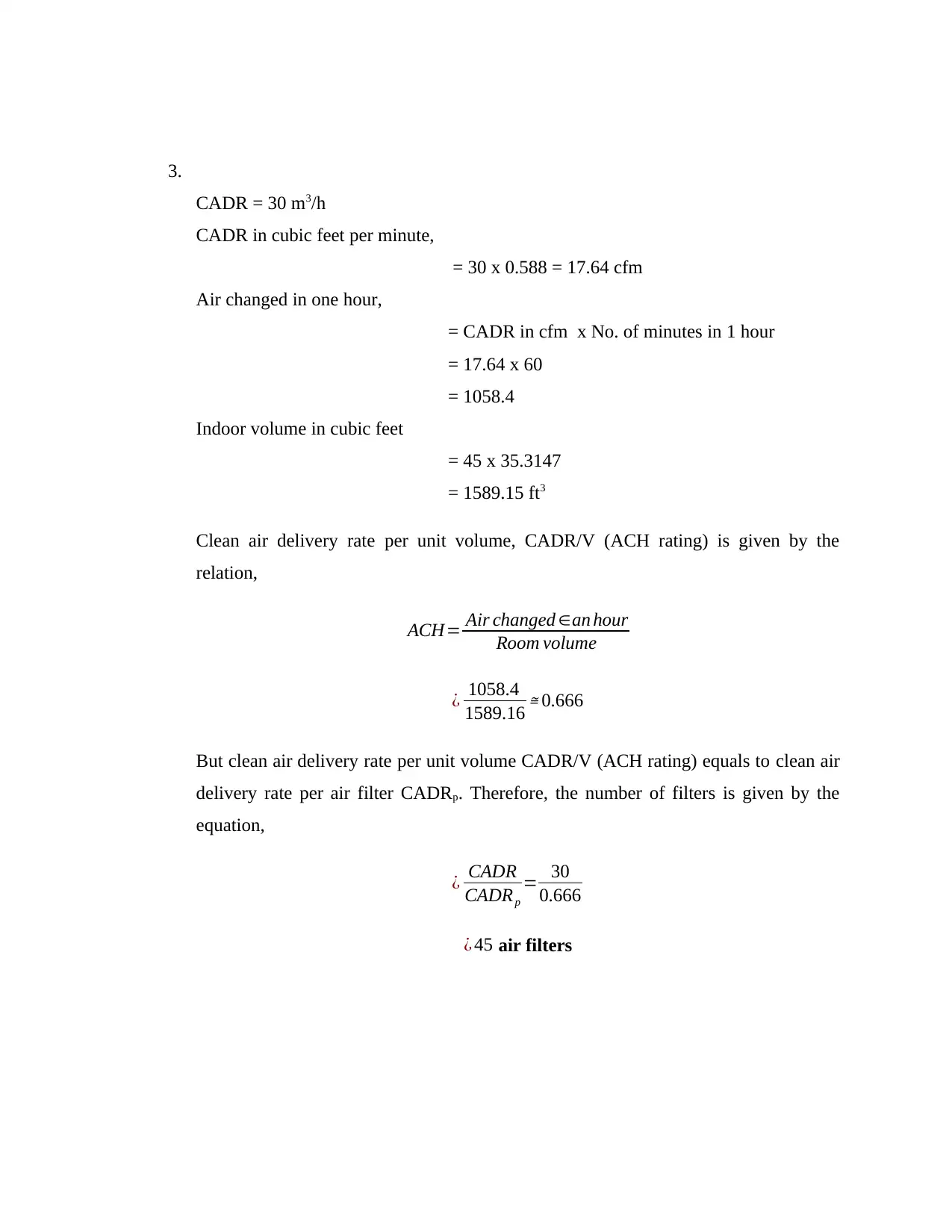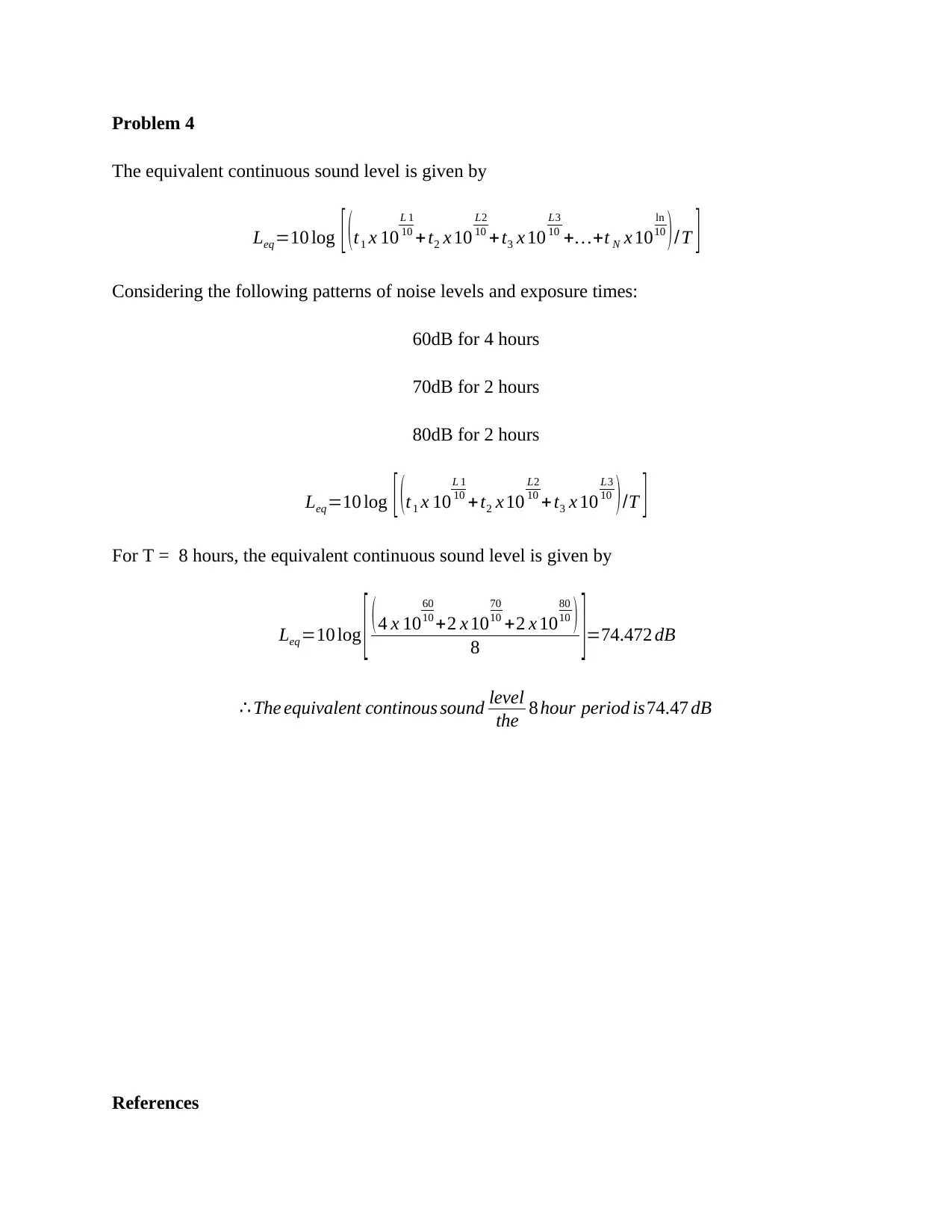Physics - CADR | Question and Answer
VerifiedAdded on 2022/08/25
|6
|823
|34
AI Summary
Contribute Materials
Your contribution can guide someone’s learning journey. Share your
documents today.

Problem 1
1. Particles whose sizes are to be measured may be molecularly homogenous or
inhomogeneous; may be organic or inorganic; may be liquid or solid; may take any
shape; may be suspended in various media; and may be isotropic or anisotropic.
Homogeneity, molecular structure, isotropy, state, suspension medium and isotropy of
particles under test may cause different response to the same particle in the size
measurement devices used (Merkus, 2016)
Spherical diameter is used because in examination of a sphere, its surface area, cross-
sectional area, volume and perimeter can unambiguously be described by a single linear
dimension -the projected section’s diameter. Moreover, the diameter of the projected
cross-section is constant despite the angle of the view. Thus in geometrical sense, a
sphere is isotropic. At all angles of view, there exists no other irregular or regular shape
that projects the same cross-section. Hence, neither volume nor surface area can be
inferred from a non-spherical particle’s cross-section.
2. How does a temperature inversion in the troposphere affect the dispersion of
pollutants?
Temperature inversion results into formation of a lid or blanket which prevents vertical
mixing/convection of warm and cool air. The lid traps the pollutants thereby preventing
their rise and dispersal. Moreover, the hydrocarbons and nitrogen oxides present in the
trapped pollutants get converted, by sunlight, to detrimental ozone which decreases air
quality (Jacko & La Breche, 2015)
3. Air quality trends in Sydney indicate that ozone levels have increased over the last
twenty years whilst NOx and VOC levels have decreased. How is this possible?
This can be attributed to two factors:
The atmosphere in Sidney may be more VOC-limited. Under such conditions, the NOx/
VOC ratios may be low hence NOx reductions can increase the ozone levels.
A decrease in NOx can reduce the amount of O3 quenched through NOx titration, resulting
to an apparent rise in the ozone levels (Jacko & La Breche, 2015)
.
1. Particles whose sizes are to be measured may be molecularly homogenous or
inhomogeneous; may be organic or inorganic; may be liquid or solid; may take any
shape; may be suspended in various media; and may be isotropic or anisotropic.
Homogeneity, molecular structure, isotropy, state, suspension medium and isotropy of
particles under test may cause different response to the same particle in the size
measurement devices used (Merkus, 2016)
Spherical diameter is used because in examination of a sphere, its surface area, cross-
sectional area, volume and perimeter can unambiguously be described by a single linear
dimension -the projected section’s diameter. Moreover, the diameter of the projected
cross-section is constant despite the angle of the view. Thus in geometrical sense, a
sphere is isotropic. At all angles of view, there exists no other irregular or regular shape
that projects the same cross-section. Hence, neither volume nor surface area can be
inferred from a non-spherical particle’s cross-section.
2. How does a temperature inversion in the troposphere affect the dispersion of
pollutants?
Temperature inversion results into formation of a lid or blanket which prevents vertical
mixing/convection of warm and cool air. The lid traps the pollutants thereby preventing
their rise and dispersal. Moreover, the hydrocarbons and nitrogen oxides present in the
trapped pollutants get converted, by sunlight, to detrimental ozone which decreases air
quality (Jacko & La Breche, 2015)
3. Air quality trends in Sydney indicate that ozone levels have increased over the last
twenty years whilst NOx and VOC levels have decreased. How is this possible?
This can be attributed to two factors:
The atmosphere in Sidney may be more VOC-limited. Under such conditions, the NOx/
VOC ratios may be low hence NOx reductions can increase the ozone levels.
A decrease in NOx can reduce the amount of O3 quenched through NOx titration, resulting
to an apparent rise in the ozone levels (Jacko & La Breche, 2015)
.
Secure Best Marks with AI Grader
Need help grading? Try our AI Grader for instant feedback on your assignments.

Problem 2
1. The clean air delivery rate (CADR) per air filter is given by the relation
CADRp =−V c
t ln ( Ct
Co )
Where,
V c is the volume of the chamber
t (h) is the elapsed time
Co is the initial concentration within the chamber
Ct is the chamber concentration after t hours
From the graphical representation given, the parameters defined above are read off as
V c=1 m3
t ( h )=5 hours
Co=100
Ct=20
Replacing these variables with their numerical equivalents, we have;
CADR=−1
5 ln ( 20
100 )
¿ 0.3219 m3 /h
2. As evaluated in (1), an air purifier of CADR=0.3219 m3 /h is required. However,
CADR in the range of (35 – 324) m3/h will be too high and thus expensive yet a lower
CADR air purifier is sufficient for the requirement.
Therefore, I would not recommend the air filter to be used to reduce airborne PM
1. The clean air delivery rate (CADR) per air filter is given by the relation
CADRp =−V c
t ln ( Ct
Co )
Where,
V c is the volume of the chamber
t (h) is the elapsed time
Co is the initial concentration within the chamber
Ct is the chamber concentration after t hours
From the graphical representation given, the parameters defined above are read off as
V c=1 m3
t ( h )=5 hours
Co=100
Ct=20
Replacing these variables with their numerical equivalents, we have;
CADR=−1
5 ln ( 20
100 )
¿ 0.3219 m3 /h
2. As evaluated in (1), an air purifier of CADR=0.3219 m3 /h is required. However,
CADR in the range of (35 – 324) m3/h will be too high and thus expensive yet a lower
CADR air purifier is sufficient for the requirement.
Therefore, I would not recommend the air filter to be used to reduce airborne PM

3.
CADR = 30 m3/h
CADR in cubic feet per minute,
= 30 x 0.588 = 17.64 cfm
Air changed in one hour,
= CADR in cfm x No. of minutes in 1 hour
= 17.64 x 60
= 1058.4
Indoor volume in cubic feet
= 45 x 35.3147
= 1589.15 ft3
Clean air delivery rate per unit volume, CADR/V (ACH rating) is given by the
relation,
ACH= Air changed ∈an hour
Room volume
¿ 1058.4
1589.16 ≅ 0.666
But clean air delivery rate per unit volume CADR/V (ACH rating) equals to clean air
delivery rate per air filter CADRp. Therefore, the number of filters is given by the
equation,
¿ CADR
CADRp
= 30
0.666
¿ 45 air filters
CADR = 30 m3/h
CADR in cubic feet per minute,
= 30 x 0.588 = 17.64 cfm
Air changed in one hour,
= CADR in cfm x No. of minutes in 1 hour
= 17.64 x 60
= 1058.4
Indoor volume in cubic feet
= 45 x 35.3147
= 1589.15 ft3
Clean air delivery rate per unit volume, CADR/V (ACH rating) is given by the
relation,
ACH= Air changed ∈an hour
Room volume
¿ 1058.4
1589.16 ≅ 0.666
But clean air delivery rate per unit volume CADR/V (ACH rating) equals to clean air
delivery rate per air filter CADRp. Therefore, the number of filters is given by the
equation,
¿ CADR
CADRp
= 30
0.666
¿ 45 air filters

Problem 3
1. The equivalent Sound Pressure level where two sources is involved given by
Lpt=10 log (10
L1
10 +10
L 2
10 )
assuming negligible interference effects.
For L1=L2=80dB
Lpt =10 log ( 10
80
10 +10
80
10 ) = 83.01 dB
∴ With bothchainsaws operating , the sound pressure level is 83.01 dB
2. The change is (83.01-80) dB = 3.01dB. Since the change in sound pressure level is
approximately 3dB, a person with unimpaired hearing will detect the increase in
sound level pressure.
3. With an additional chainsaw to the two operating ones, the sound pressure level is given
by
Lpt=10 log (3 x 10
L
10 )
where L=L1=L2=L3 =80 dB
Thus Lpt=10 log ( 3 x 10
80
10 ) =84.77 dB
This implies that the change in sound pressure level = (84.77 – 83.01) dB = 1.76dB
Since the change in sound pressure level is less than 3dB, a person with unimpaired
hearing will not detect the increase in sound level pressure.
1. The equivalent Sound Pressure level where two sources is involved given by
Lpt=10 log (10
L1
10 +10
L 2
10 )
assuming negligible interference effects.
For L1=L2=80dB
Lpt =10 log ( 10
80
10 +10
80
10 ) = 83.01 dB
∴ With bothchainsaws operating , the sound pressure level is 83.01 dB
2. The change is (83.01-80) dB = 3.01dB. Since the change in sound pressure level is
approximately 3dB, a person with unimpaired hearing will detect the increase in
sound level pressure.
3. With an additional chainsaw to the two operating ones, the sound pressure level is given
by
Lpt=10 log (3 x 10
L
10 )
where L=L1=L2=L3 =80 dB
Thus Lpt=10 log ( 3 x 10
80
10 ) =84.77 dB
This implies that the change in sound pressure level = (84.77 – 83.01) dB = 1.76dB
Since the change in sound pressure level is less than 3dB, a person with unimpaired
hearing will not detect the increase in sound level pressure.
Secure Best Marks with AI Grader
Need help grading? Try our AI Grader for instant feedback on your assignments.

Problem 4
The equivalent continuous sound level is given by
Leq=10 log [ (t1 x 10
L 1
10 +t2 x 10
L2
10 + t3 x 10
L3
10 +…+t N x 10
ln
10 )/T ]
Considering the following patterns of noise levels and exposure times:
60dB for 4 hours
70dB for 2 hours
80dB for 2 hours
Leq=10 log [ (t 1 x 10
L 1
10 +t2 x 10
L2
10 + t3 x 10
L3
10 )/T ]
For T = 8 hours, the equivalent continuous sound level is given by
Leq=10 log [ ( 4 x 10
60
10 +2 x 10
70
10 +2 x 10
80
10 )
8 ]=74.472 dB
∴ The equivalent continous sound level
the 8 hour period is74.47 dB
References
The equivalent continuous sound level is given by
Leq=10 log [ (t1 x 10
L 1
10 +t2 x 10
L2
10 + t3 x 10
L3
10 +…+t N x 10
ln
10 )/T ]
Considering the following patterns of noise levels and exposure times:
60dB for 4 hours
70dB for 2 hours
80dB for 2 hours
Leq=10 log [ (t 1 x 10
L 1
10 +t2 x 10
L2
10 + t3 x 10
L3
10 )/T ]
For T = 8 hours, the equivalent continuous sound level is given by
Leq=10 log [ ( 4 x 10
60
10 +2 x 10
70
10 +2 x 10
80
10 )
8 ]=74.472 dB
∴ The equivalent continous sound level
the 8 hour period is74.47 dB
References

Jacko, R., & La Breche, T. (2015). Air Pollution and Noise Control. Environmental Engineering,
309-393.
Merkus, H. G. (2016). Particle Size, Size Distributions and Shape. Particle Size Measurements,
13-42.
309-393.
Merkus, H. G. (2016). Particle Size, Size Distributions and Shape. Particle Size Measurements,
13-42.
1 out of 6
Your All-in-One AI-Powered Toolkit for Academic Success.
+13062052269
info@desklib.com
Available 24*7 on WhatsApp / Email
![[object Object]](/_next/static/media/star-bottom.7253800d.svg)
Unlock your academic potential
© 2024 | Zucol Services PVT LTD | All rights reserved.